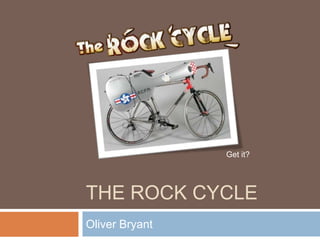
The Rock Cycle - Science
- 1. THE ROCK CYCLE Oliver Bryant Get it?
- 2. What are the different types of rock? Sedimentary rocks Igneous Metamorphic
- 4. Sedimentary rocks Small fragments of rocks fall to the sea bed and build up in layers, a process called sedimentation. The sediments get compacted and the water squeezed out from between them. The small rock pieces and crystals cement together to form sedimentary rocks over millions of years! The oldest layers are at the bottom and the youngest at the top. There are sometimes fossils.
- 6. Igneous rocks Igneous rocks are formed by lava and magma cooling down. They contain randomly arranged interlocking crystals. The slower they cool, the bigger the crystal. Obsidian is an extrusive igneous rock containing small crystals formed when magma erupted from volcano. Granite are intrusive igneous rocks formed when magma cooled slowly underground, it has large crystals.
- 8. Metamorphic Metamorphic rocks are formed from other rocks that change due to heat or pressure because of earth movements. They do not melt, but the chemical formula changes. When Shale crystals are put under pressure they become arranged in layers to form slate. Marble is formed from limestone.
- 9. Erosion Erosion is the process of breaking things down, large things into small. Boulders become rocks, rocks become sand. There are three main types of weathering – The process when rocks gradually wear away. Physical Physical weathering is caused by changes in temperature, freezing, thawing, wind, rain and waves. An example is when water gets into a crack in a rock and freezes, it expands and cracks the rock more! If the ice melts, more water gets into the crack, if the rock freezes again the crack gets even bigger until a piece of rock falls off. Biological Biological weathering is caused by animals and plants wearing away the rock. For example plant roots grow into cracks, making them bigger until eventually the rock falls away. Animals can cause weathering too by walking, climbing and burrowing in the Chemical Chemical weathering is caused by chemicals, especially in the rain. The rain is slightly acidic so some minerals react causing the rock to weather. For example chemical weathering can cause the creation of caves.
- 10. David David is a marble statue sculptured in Florence, in 1504. Marble is a metamorphic rock, that was formed from limestone. If it was outside, David would be exposed to physical and chemical weathering.
- 11. Ramesses II He was created 1000BC in Egypt, he is made of granite. Granite is more resistant to weathering because the grains of granite are very close together and are very strong!
- 12. Sediment in rivers gets deposited as the river slows down. Bigger and heavier particles like pebbles and sand are deposited first. The lighter silt and clay only settle if the water is almost still. Deposition of sediment
- 13. Tectonic Plates The Earth's surface is made up of a series of large plates (like pieces of a giant jigsaw puzzle). These plates are in constant motion travelling at a few centimetres per year. The ocean floors are continually moving, spreading from the centre and sinking at the edges. Convection currents beneath the plates move the plates in different directions. The source of heat driving the convection currents is radioactive decay which is happening deep in the Earth. The edges of these plates, where they move against each other, are sites of intense geologic activity, such as earthquakes, volcanoes, and mountain building.
- 14. Plate Boundaries There are a number of different types of plate boundary. Collision zones form when two continental plates collide, an example of this is the Alps and Himalayas. Neither plate is forced under the other, and so both are forced up and form fold mountains.
- 15. Constructive Boundaries Constructive boundaries form when plates move apart. Volcanoes are formed as magma rises from the mantle when the land splits. They usually under the sea, an example being the mid Atlantic ridge. E.g. In Iceland
- 16. Destructive Boundaries Destructive boundaries occur when oceanic and continental move towards each other. An example is the Nazca Plate in the Andes. Where this happens it is called the Subduction zone.
- 17. Subduction zone Subduction volcanoes occur where the earth’s plates move towards each other and collide. The areas where this happens are called destructive plate margins, because the earth’s crust is being destroyed. One plate, usually the one that is heavier, is forced to dive (subduct) beneath the other into the mantle, causing it to heat up and melt. This melted material (magma) pushes its way back to the earth’s surface under great pressure, and often erupts explosively (as lava). The area where the two pieces of crust are in contact is called the subduction zone.
- 18. Conservative Boundaries A conservative plate boundary occurs where plates slide past each other in opposite directions, or in the same direction but at different speeds. Friction is eventually overcome and the plates slip past in a sudden movement. The shockwaves created produce an earthquake. This occurs at the San Andreas Fault in California.
- 19. Haiti Earthquake Haiti is on the boundaries of the Caribbean and North American Conservative pates. In 2010 magnitude 7 earthquake hit Haiti. Buildings were poorly built and not earthquake resistant and there were very few resources. 1,300,000 made homeless 300,000 Injured 220,000 Dead
